Euan Macleod Interview
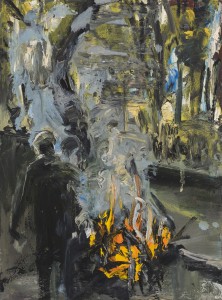 On November 3, 2010, I visited Euan Macleod at his home in Haberfield. I was writing a story for the Daily Telegraph, Sydney, about Euan’s survey show at the S.H. Ervin Gallery. Titled Surface Tension: The Art of Euan Macleod, 1991-2009, the exhibition was to open on November 12 and tour to regional galleries after its closure at the S.H. Ervin on December 19.
On November 3, 2010, I visited Euan Macleod at his home in Haberfield. I was writing a story for the Daily Telegraph, Sydney, about Euan’s survey show at the S.H. Ervin Gallery. Titled Surface Tension: The Art of Euan Macleod, 1991-2009, the exhibition was to open on November 12 and tour to regional galleries after its closure at the S.H. Ervin on December 19.
This was not my first meeting with Euan. Indeed, I had first met this artist on the day he won the Archibald Prize in 1999. Winning that prize for his painting, Self Portrait/head like a hole, set Euan on the path to success which he has since followed with a singleness of purpose and a self-deprecating amiability.
After meeting him at the Archibald all those years ago, I interviewed Euan on quite a few occasions when he was having exhibitions or when he had won other prizes. I recall interviewing him at the National Art School on one occasion, where he taught until this year (2010). His students apparently referred to him as “the professor”, and his patient, slightly shambling demeanour would certainly have endeared Euan to them.
So, here is my November 3 interview with Euan, which I have edited only lightly. We sat in the studio he had built in the large, rambling backyard of his home, drinking strong black coffee. Photographer Bob Barker was with us, and he appears in some of the pictures I took myself on that day.
Elizabeth Fortescue, November 26, 2010
Euan said his first survey exhibition had been in Newcastle in 1998, just before he won the Archibald. He humorously contrasted the process of setting up the Newcastle show with the far more white-glove approach at the S.H. Ervin, now that he is a well-known artist.
Euan: [For the Newcastle show] I drove round and picked up a lot of the paintings on the roof racks. This time a lot of people have insisted they are crated on the premises. Some people wanted me to paint replacement paintings. [The 2010 survey show begins with work from 1991 when Euan’s work was still evolving.] The work was very much about the figure in an interior, and I just didn’t deal with the landscape. I didn’t want to.
Later, Euan said, the figure got smaller and smaller and the landscape got more important. Now the figure comes and goes. He also spoke about the new book, Euan Macleod: The Painter in the Painting, by Gregory O’Brien, published by Piper Press, 2010.
It’s a lovely thing to have and I love the way he’s done it. It’s beautifully written.
Euan spoke about the painting called Digging, Painting, Eating, from 2005.
It’s a bit of a reference to [Philip] Guston‘s paintings. A homage to him, really. Those beautiful paintings of him in the studio and smoking. I love those works. He does those big cartoon heads and he’s always got the prickly, you know, shaving. There’s always very personal references to the act of painting, the solitude maybe. That was just a reference or starting point for it all. I think the painting’s in Philadelphia, in a private collection.
We stopped [the survey show] at 2009, so that was just when I was beginning the Antarctic works. They kind of end it. Whereas the book goes a bit further and includes the show I had at Watters.
I sometimes worry that the work that you’re doing, to include it in a show is kind of hard because you’re closest to it so you want it. You say, ‘oh what about this one I did this morning, can’t we put that in?’ But you haven’t had a chance to kind of tell whether it’s any good or not. You look back at it later on and you go, ‘oh fuck they were dodgy works, they were shockers’.
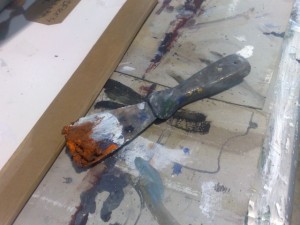 In a way I think you can be too seduced by what you’re doing now and that was the benefit of having Gavin [Wilson] curating the show and Greg [O’Brien] writing the book. I left it pretty much up to them what they chose. Gavin pretty much chose the work for the show. He made the selection. I had a little bit of input, but as little as I possibly wanted and I was really pleased with how he’d worked it out. My problem was so and so has supported me, we’ve got to have one of his paintings in. Whereas Gavin was totally objective. I’m thinking I’ve got to put the same number in from Niagara as Watters [galleries which show Macleod’s work]. So you’re worried about keeping everyone happy. The writer and curator were much more objective than I could ever have been. I would suggest things and say ‘what about this one?’, and they might just look the other way or smile. ‘We might be able to get that one in if the book stretches to 2000 pages.’
In a way I think you can be too seduced by what you’re doing now and that was the benefit of having Gavin [Wilson] curating the show and Greg [O’Brien] writing the book. I left it pretty much up to them what they chose. Gavin pretty much chose the work for the show. He made the selection. I had a little bit of input, but as little as I possibly wanted and I was really pleased with how he’d worked it out. My problem was so and so has supported me, we’ve got to have one of his paintings in. Whereas Gavin was totally objective. I’m thinking I’ve got to put the same number in from Niagara as Watters [galleries which show Macleod’s work]. So you’re worried about keeping everyone happy. The writer and curator were much more objective than I could ever have been. I would suggest things and say ‘what about this one?’, and they might just look the other way or smile. ‘We might be able to get that one in if the book stretches to 2000 pages.’
Actually the writer, he changed. There were works he hadn’t liked as much initially and he grew to like them a lot more. For myself I think that was interesting because I’ve been a little bit, not dismissive of them, but I wondered about them myself and it was actually nice that he grew to really like those ones. The ones that were much more chaotic. [Like the work depicted on the back of the book. It is titled Starry night, 2002.] I literally poured the paint on. That’s a wee self portrait. It’s hard to see.
The Archibald painting is in [the survey show]. UTS owns it. I must say I was wondering about putting it in. Because of the intensity of that whole experience [winning the Archibald] I grew to hate the painting. But I suppose in doing the book both the writer and curator were quite positive about it and it was an opportunity to see it in context rather than just seeing it as an isolated work, because in the Archibald it was totally taken out of context. it was seen on its own, no one ever realised it was actually related to a whole group of work. So it’s a little bit more of reclaiming ownership of it I suppose. When I see it in the show I might not think that. I might go, ‘ooh’.
Was it actually part of a series?
Yeah. And this one where the figure’s hidden. It was actually a bit of a piss-take because it was that idea of new age painting where the figure is incorporated into the landscape where you have the woman lying down and she becomes part of the hills. It was actually a bit of a reference to that kind of work. That’s what the dolphins were implying. But no one really got that. Too bad, my irony didn’t work. I don’t think I’m a very good post-modernist. At the time [of winning the prize] it was quite hurtful, the whole process. People said some really nasty things.
[I commented that Euan’s win had also been very popular among many people.] It’s better to have won it than not, though?
Yeah. I was saying to someone else that I wish I had been able to distance myself from the prize a little bit more in that I took it too seriously. Whereas I don’t think a lot of people do take it seriously. But as an artist to be able to distance yourself from your work is very difficult. You’re desperately trying all the time not to do that, to be close to it. Especially being a self portrait it encourages that whole idea [that] if someone’s criticising the work they’re actually criticising you. And they’re not. If I criticise your writing I’m not saying you’re a bad person, but it feels that way.
Euan entered the Archibald on only one subsequent occasion, with a portrait he did of Frank Croll, who died soon afterwards. He has no desire to enter again.
I just feel it’s best to leave it to someone else. You’re sort of taking up someone’s spot. And I didn’t enjoy it the first time. I didn’t want to ever enter it again, but it was just this one guy. It was the most amazing experience because he was terminally ill. It was an amazing interaction. He was a heart specialist and his one regret was he hadn’t been able to paint. I said, ‘mate, just do it. You don’t need to show anybody.’ Because a lot of collectors are frustrated artists in a way. They are people that wanted to do it themselves and for whatever reason felt they weren’t good enough and by buying [artists’ work] you’re doing the worst thing. You’re buying the best examples. It’s like thinking ‘what shall I paint? I’ll go along to the National Gallery in London and get a few ideas’, and you’re just totally humbled.
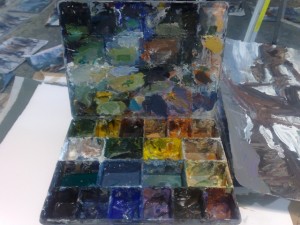 Is the survey show comprised only of paintings?
Is the survey show comprised only of paintings?
In the show we’ve got a couple of works on paper, en plein air. They’re the ones I did on the boat. And the group that won the Parliamentary Prize. Whenever I go on holidays or things … [Euan showed me a stack of plastic, segmented fishing tackle boxes which he fills with acrylic paints of many different colours and takes with him en plein air.] You can open it up and the paints remain dry. You can carry them around. You can take them overseas, you can do anything with them. I go out, open it up and you’re painting in about two seconds. It’s fantastic. I’ve put hundreds of people on to them. They’re fishing tackle boxes. I just take one. That’s a really old crappy one. Once they’re used up you can just peel all the paint off and reuse them. I normally use oil (on the canvases.) A lot of the stuff when it’s drying I can scrape it on. You can put it on like that and you can get a lot of nice texture with it. You’re getting a bit of grit and stuff on it. I love it sort of drying up. It’s fantastic.
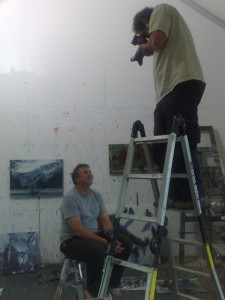 How long have you lived in Haberfield?
How long have you lived in Haberfield?
We moved here about 10 years ago. Built the studio. Probably about half the show [has come out of this studio].
I don’t have a set working pattern. You know how some people work nine to five. I don’t do that. It’s probably more when I’ve got time. I’ve been finding the business side of it takes a long time. The show and the book have been incredibly time consuming. I worked up until this year [at the NAS].
Has it liberated you not to have a job?
No, only because of the show and the book have taken up most of the year. They have been very time consuming. There’s an irony to that really. That public side of it all. It’s been important to me to keep into the studio as much as I can, but it has felt like grabbing time to do it.
After the show will that change?
I’m certainly thinking it will.
Tell me about the large figure seated in the landscape; sitting on the coastline.
I wish I had been able to put more in. In the book that’s one of the periods where there’s not so many of them. They’re kind of giants. I wanted the scale to be slightly ambiguous and see that blue thing is like a head, a face, which is my father’s head. And that’s a reference to this painting which is far more obvious. That’s my father’s head. I guess he looks a bit like me.
There’s all sorts of connotations. There’s a personal mythology and a public one. That’s something Gavin pointed out. In a way I see them as him [my father]. The big figures. He’s kind of lost, in a way. He had Alzheimer’s so he was lost. When he died my mother brought him home. We’re not that religious and we’re certainly not Catholic and yet she had him laid out in a coffin exactly where the boat was. [Euan’s father had built a yacht inside the family home in New Zealand. When it was ready to be launched, Euan’s father actually dismantled the front window of the house to get it out.] I don’t think she thought about it. That’s a painting that I did of it up there. I made it a boat. It was just a coffin. With the boat pointing out the window. Which is kind of beautiful. There’s something very poetic about it. I guess it’s become a bit clumsy now in terms of the retelling of it. But a lot of that came out in the painting. Like I painted him in the boat but you think about it and it’s obvious to put him in the boat. He built it and he sort of gave birth to it through the window. So there’s lots of references to that in here. Possibly more in the book.
Part of it was that idea, and the road, too, where the son’s looking at the dead father and thinking ‘how am I going to go on?’. There’s that sense of the father.
Were you close to your dad?
No. And probably the painting is a way of connecting. I don’t think I ever quite knew him, or vice versa, actually. He got sick when he was quite young. I remember being down in Rozelle Bay or wherever it is and there was a guy standing up in his dinghy which of course you’re not supposed to do, and it really inspired me. I went home and painted. But of course there’s that photo [of his father standing up in his dinghy]. It’s fascinating. So I think a lot of painting is pulling images up from the subconscious and they probably have some kind of meaning on some level but I guess the trick is not to make them too personal otherwise other people think what a big wank. So it has to have some kind of universal significance in some way. But so many people have said to me, ‘my dad was into boating’. A shared history, I suppose. But the whole idea of the boat. It’s fascinating. Just as a means of transport. Going from one place to another, which the walking figure is as well.
What about the walking figure trailing clouds of smoke, which is often in your work?
Yeah, I don’t know what that was all about.
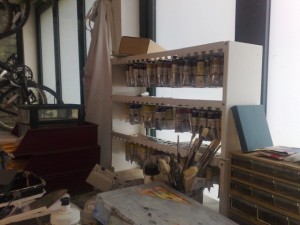 [I said I like not knowing in a way, because it allows the imagination to wander.]
[I said I like not knowing in a way, because it allows the imagination to wander.]
That’s a lovely way of putting it. If you tried to work it out, once you think, ‘oh that’s why I put the boat in the room’, when you paint it next it’s illustration. You’ve got to be careful it’s not illustration. It was Philip Guston I think who was going on about not wanting to know where all the stuff came from, almost as if it would kill it off. I don’t know if I agree with that, but there’s a fear of …. I think you keep coming up with mystery. I don’t think you know everything. There’s a big wide world. But it is fascinating on that private level just how things come out, and where they come from.
Certainly I love that idea of a relationship between the figure and the landscape, trying to keep it fresh, thinking in terms of the figure as clouds or the materiality of the figure.
Copyright, Elizabeth Fortescue, 2010
| Print article | This entry was posted by Elizabeth Fortescue on November 26, 2010 at 11:27 am, and is filed under Uncategorized. Follow any responses to this post through RSS 2.0. You can leave a response or trackback from your own site. |
